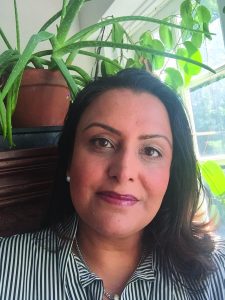3 Questions with Dr. Neeti Bathala

What motivated you, a University-level Professor, to write books for a distinctly younger audience than you usually teach?
My goal was simple: to get young people to realize that anyone can become a scientist. I was originally motivated by my college students; many had expressed to me over the years that they did not believe that they could be scientists and had therefore, decided to pursue other career paths. A common sentiment was that they wished they had been exposed to additional science at a young age and realized how much fun it could be. I have been using Citizen Science projects in my classes to show students that anyone can contribute to actual research. These projects allow members of the public to engage in the process of scientific investigation: asking questions, collecting data, and/or interpreting results.
In my book Moonlight Crab Count, Leena a young girl assists her mother in counting horseshoe crabs as part of a Citizen Science project at the shore. My objective was to present the acquisition of data as an enjoyable and enchanting experience that juxtaposes scientific data collection with a compelling storyline. Leena spends a magical night at beach with her dog, learning about the horseshoe crab and its vital role in the medical field. She has the opportunity to be on a boat under darkness, collecting data in the bay. The experience is captivating and certainly accessible for young children. The goal is to get young children excited about nature and the environment, and to demonstrate that their contributions are important now, as well as into the future.

How did you become involved in field-work and Citizen Science?
My teaching, research and writing has been motivated by my own experiences doing field-work. In high school I had an AP Biology teacher that instilled that knowledge was not only found in the classroom or laboratory, but experienced by getting out in nature. It was being in the field that truly made science meaningful. I had the opportunity to do significant field-work during my graduate studies. One of the most memorable experiences was spending a summer at the Duke University Marine Laboratory. An evening wading into the ocean identifying species and collecting data was the motivation for Moonlight Crab Count. The magic of bioluminescence and the ocean at night compelled me to continue to study marine ecosystems and to seek out field-based research opportunities.
In designing my classes, I certainly wanted students to have the experience of field-based data collection, regardless of their academic background. I incorporated a Citizen Science project based out of Cornell University into their coursework. Students could contribute to the Celebrate Urban Birds project identifying focal species in Philadelphia. The straightforward nature of the project allowed all to engage, even without prior knowledge of bird species. The students enjoy this opportunity immensely and look forward to getting outside and participating in actual data collection. Their enthusiasm has prompted me to integrate multiple Citizen Science projects into my curriculum.
In addition to students, young and old, how are you involved in your community getting the general public excited by science?
Locally, I am involved in the Haddonfield Garden Club in South Jersey as well as serve on the Board of Directors of the Clean Air Council in Philadelphia. Both of these organizations engage in civic and environmental projects that enhance the public awareness of scientific and conservation principles. I am an ecologist by training and promote these principal concepts right in my backyard. I have created gardens that enhance wildlife potential and encourage native plantings. It is a pleasure to share my knowledge with the public and assist others in finding Citizen Science projects or designing their landscape to maximize natural diversity. Given my proximity to the oceans and bays, I am also involved in coastal conservation efforts.
My endeavors now are directed at making science accessible to all so that they, too, can experience the joys of scientific field-work. I continually seek encounters that can involve a younger audience so that the STEM based fields are presented to the general population. I was especially motivated in writing Moonlight Crab Count to have a young girl as a burgeoning scientist. I hope to continue to encourage scientific inquiry and to allow everyone to see that their contributions are meaningful at any age.
About Dr. Neeti Bathala
Dr. Neeti Bathala is an Associate Professor of Ecology and Environmental Sciences at the University of the Arts in Philadelphia. Her research has brought her across the world, studying everything from bottlenose dolphins in Greece to sea turtles in Costa Rica. Neeti’s academic efforts involve research and teaching to make science accessible and enjoyable to all. Moonlight Crab Count is her debut picture book. Neeti lives in New Jersey and is an avid gardener, creating diverse ecosystems with native plantings. She spends her summers at the Jersey Shore where she is active in local conservation efforts of horseshoe crabs and other marine animals.

